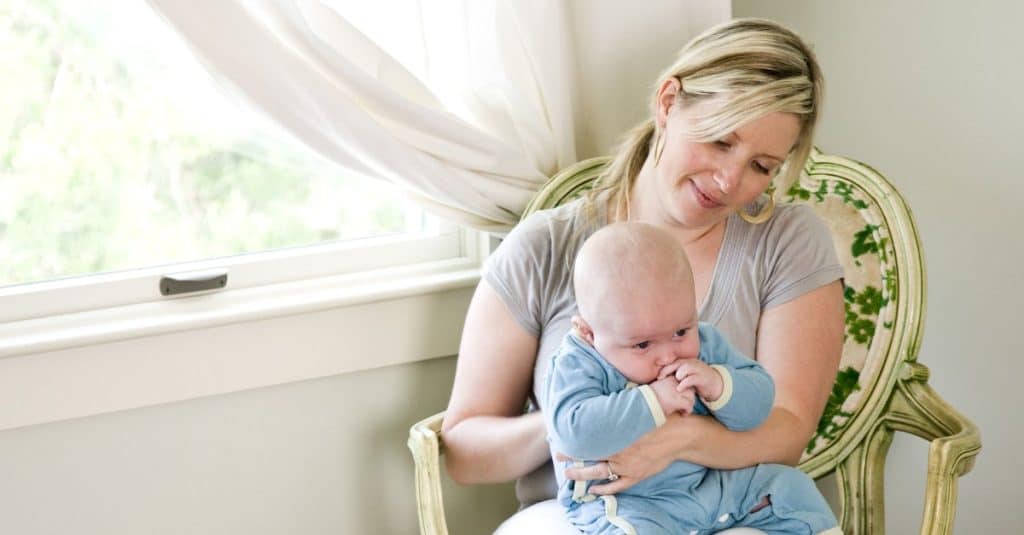Burping is a rite of passage for babies and their caregivers. Most of the time, it shouldn’t take more than a few minutes for a baby to get the air out. However, there are times when a baby just won’t burp, even after what seems like an eternity of back pats.
There are a few techniques you can use to help a baby burp. Switching positions, doing burping exercises, and massaging are a few that may help a baby burp after feeding. Sometimes, moving your hand around while rubbing or patting can help you find the right “spot” to get the air out.
Why Do Babies Need to Be Burped?

While babies feed, they don’t just swallow milk, they also swallow some air with each gulp. The good bacteria in your baby’s gut also release gases as they assist in food digestion. Some of this air gets trapped and accumulates in their esophagus and stomach, causing discomfort.
Unlike older children and adults who can burp on their own, babies whose digestive muscles are not yet well-developed need some help getting rid of this excess air.
Burping is an important part of feeding a baby. It helps them get rid of air that they may have swallowed while drinking milk. Burping helps babies spit up less and feel more comfortable after a feeding. Burped babies might also be less cranky and gassy.
Burping a Hard to Burp Baby
Switch Positions
Sometimes, shifting a baby’s position helps air in their stomach travel upwards and out. A hard-to-burp baby may benefit from alternating between two or more of these positions. If your baby won’t burp in one position, wait a few minutes and try again using another position.
-
Over the Shoulder

Hold your baby facing towards you, with their chin resting on your shoulder. Use one hand to support them in this upright position against your chest and shoulder. With the other hand, use firm but gentle pressure to pat or rub up and down your baby’s back.
-
Sitting on Your Lap

This position may be more effective for babies with a little more neck strength, as it involves sitting your baby in an upright position.
Hold your baby in your lap facing sideways away from you. Rest the heel of your hand on their chest and use your thumb and index finger in a U-shape to support their chin and jaw, being mindful not to put pressure on their throat. Lean them forward slightly at the waist and use your free hand to pat or rub their back.
This position can also be performed with your baby sitting on a firm surface such as a changing table or crib instead of on your lap.
-
Lying on Your Lap

Let your baby lie prone on your lap, with their head higher than their chest. Use the heel of one hand to support your baby’s chest and your thumb and index finger in a U-shape to support their chin and jaw without putting pressure on the throat. Use your free hand to pat or rub their back.
-
Lying Across Your Forearm
Hold your baby across your forearm facing away from you. Their head should be supported by your elbow and their belly by your palm. Their mouth should face outward. Use your free hand enough space to give back pats or rubs.
This position is also sometimes referred to as the colic hold, and will look similar to a football hold for breastfeeding, but with your baby facing away from you.
Do Burping Exercises
-
Cycling
With your baby lying supine, move your baby’s legs in a circular fashion, as if they were riding a bicycle.
You can also modify this technique and do bicycle crunches. Hold your baby’s right leg bent at the knee in one hand and their arm in the other hand. Slowly bring the knee to the elbow. Bring both limbs back down and repeat with the opposite arm and leg.
-
Bounce on an Exercise Ball
Gentle up and down movement may help to move trapped air and gas in your baby’s stomach. Hold your baby in a burping position and sit securely on an exercise ball. Pat or rub their back while you bounce on the ball.
-
Rock and Roll Back and Forth
With your baby sitting on your lap, support their head and neck with one hand like you would burping them in your lap. With the other hand, support their neck and upper back. Gently rock their upper body back and forth and from side to side to help bring the gas up and out.
Massage Out the Burp

This method may work better to move gas downward and out the bottom end. If your baby has just finished feeding, wait at least 45 minutes before massaging to reduce the risk of vomiting.
While not necessary, you may opt to use a baby-safe oil or lotion to reduce the friction on your baby’s skin. An edible oil such as coconut or almond is a good choice, in case they ingest some. Do not use essential oils on or around your baby until they are at least 3 months.
Several massage techniques may help trapped air and gas move through your baby’s system. You may try using several until you find one that they enjoy best.
- Using both palms, use light pressure to massage your baby’s stomach in a clockwise motion. Begin at 7 or 8 o’clock and move your hands one after another across your baby’s belly.
- Use your hands like paddles, pinky finger side facing your baby. Position your hands horizontally across the top of their belly, just below where the ribcage ends. Move your hands down the length of their belly.
- Position your thumbs on either side of your baby’s belly slightly higher than their navel. Slide your thumbs away from each other while gently pressing in.
Other Ways to Reduce Gassiness
-
Use the Right Nipple
Nipples that have a higher flow rate than your baby can handle can cause them to take in too much air as they try to keep up with the milk coming into their mouth.
On the other hand, the same can happen if the nipple flow is too slow. Your baby will need to suck extra hard to get a good mouthful of milk, and they will inevitably ingest more air while feeding.
If you are combination feeding, choose a bottle nipple that matches what your baby gets at your breast. Your baby will also give you signs if a bottle nipple is too small or too large for them.
Take a look here for an easy guide on choosing the right nipple size.
-
Burp While Feeding
Instead of burping just once at the end of the feed, try burping once every ounce while bottle-feeding. If you are breastfeeding, try burping every five minutes or every time you switch breasts.
-
Use an Anti-Colic Bottle
When a traditional baby bottle is screwed shut, air and liquid can only come in and out through the nipple. Eventually, a vacuum will form and your baby will need to suck harder and harder as the bottle empties.
As the vacuum becomes stronger, air will eventually force its way into the bottle through the only entrance it can find – the same one which your baby is drawing milk from. Air bubbles will accumulate in the milk – air bubbles that your baby ends up ingesting along with their milk.
Anti-colic bottles use venting systems that allow air to enter the bottle through a separate channel than that which a baby uses to suck milk from. The milk in the bottle won’t become as aerated and your baby won’t need to progressively suck harder to work against an air vacuum.
-
OTC Medicine
As with any kind of medicine, have your baby’s pediatrician sign off on using medication to help a baby that won’t burp. Simethicone gas drops are commonly used to treat colic and wind in infants.
-
Diet
A breastfeeding person’s diet affects the composition of their breastmilk to some extent. Dairy, certain vegetables such as legumes, high-carb foods, and foods containing the artificial sweetener sorbitol can contribute to excess gassiness.
Foods that give you gas may also be giving your baby gas problems. Experiment with slight modifications to your diet and see if they help with your baby’s gas. It is also important to note, however, that the foods causing gas in your baby might not be the same ones that cause gas in you.
What If My Baby Won’t Burp?
Don’t worry too much if your baby won’t burp, but isn’t visibly uncomfortable and doesn’t seem bothered by gas. Chances are, they aren’t burping because there isn’t enough gas present for them to burp out in the first place.
A one-off occasion where your baby won’t burp isn’t likely going to be any major cause for concern. Air that makes its way into your baby’s digestive tract will eventually come out through one end or the other.
A study conducted in 2014 had one group of mothers burp their babies after each feed, and another group not burp their babies. The study found that there was no significant reduction in the number of colic episodes in babies from the burping group versus the non-burping group.
If your baby is consistently hard to burp and struggles with colic and gassiness, a visit to your child’s healthcare provider may help rule out any medical issues associated with the problem, such as protein or lactose intolerance.